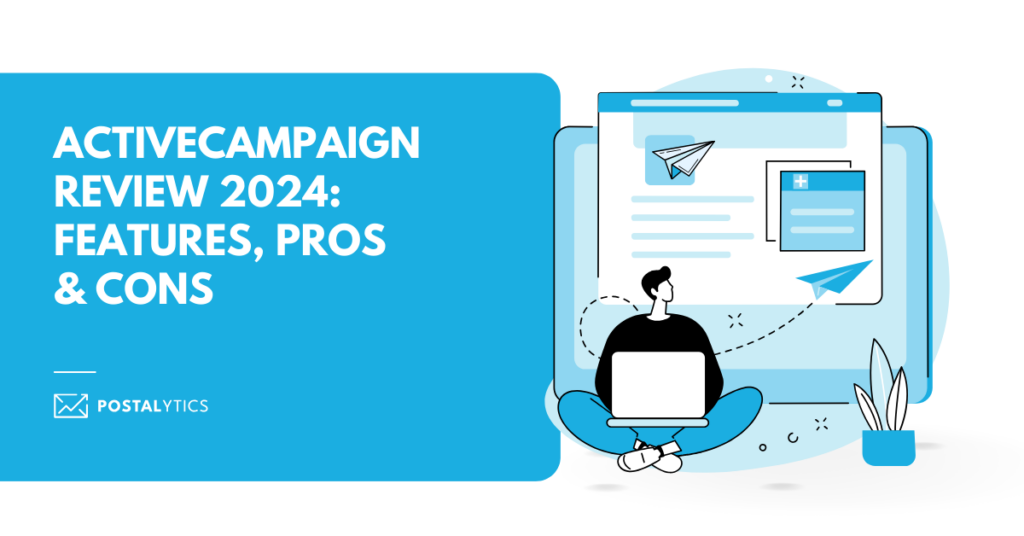
ActiveCampaign is an all-in-one platform for businesses looking to create and automate personalized customer experiences. It has customers across 170 countries and offers a variety of features to cater to different needs.
If you want to adopt the platform (or are considering alternatives), you’ve come to the right place.
For this review, we’ve considered features, case studies, customer testimonials and user reviews on third-party platforms. We’ve also examined the integration capabilities with our direct mail automation tool – Postalytics.
Table of Contents
- How Does ActiveCampaign work?
- Core Features of ActiveCampaign
- Pros of ActiveCampaign
- Cons of ActiveCampaign
- Plans and Pricing of ActiveCampaign
- Try Out ActiveCampaign-Postalytics Integration
How Does ActiveCampaign Work?
ActiveCampaign is a comprehensive marketing automation platform designed to streamline businesses’ marketing efforts. It enables users to
- Create personalized email marketing campaigns,
- Automate customer journeys,
- Manage contacts,
- Analyze campaign performance.
The platform offers a suite of marketing automation tools, omnichannel marketing, audience management, content creation, analytics and reporting. It also supports various types of automation, such as email marketing, SMS, site messaging, and CRM automation.
Notably, it integrates with direct mail automation tools. This allows businesses to send physical mail as part of their marketing strategy, enhancing customer engagement through a multi-channel approach.
Core Features of ActiveCampaign
ActiveCampaign has added many different features to its platform since it launched. Here are the top 8 features that businesses most use.
1. Marketing Automation
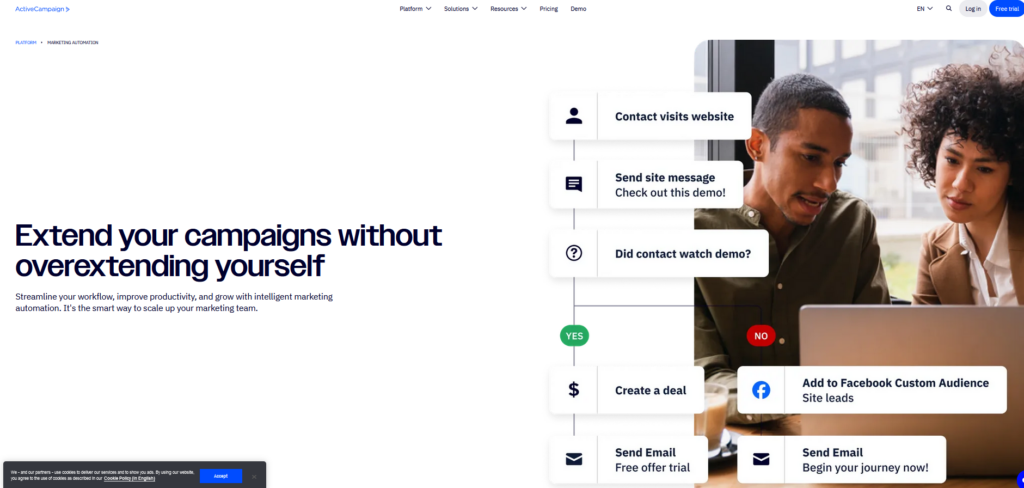
ActiveCampaign’s advanced automation feature streamlines and optimizes marketing processes. It allows businesses to create complex workflows that automate tasks, personalize interactions, and manage leads.
Its key components include;
- Automated email campaigns that trigger based on specific actions,
- Visual customer journey mapping to design tailored experiences,
- Lead scoring to prioritize high-potential customers.
Its integration with CRM systems ensures seamless lead management and enhances sales processes. These automation capabilities help businesses deliver messages at the right time, boosting customer engagement and conversion rates.
2. Omnichannel Marketing
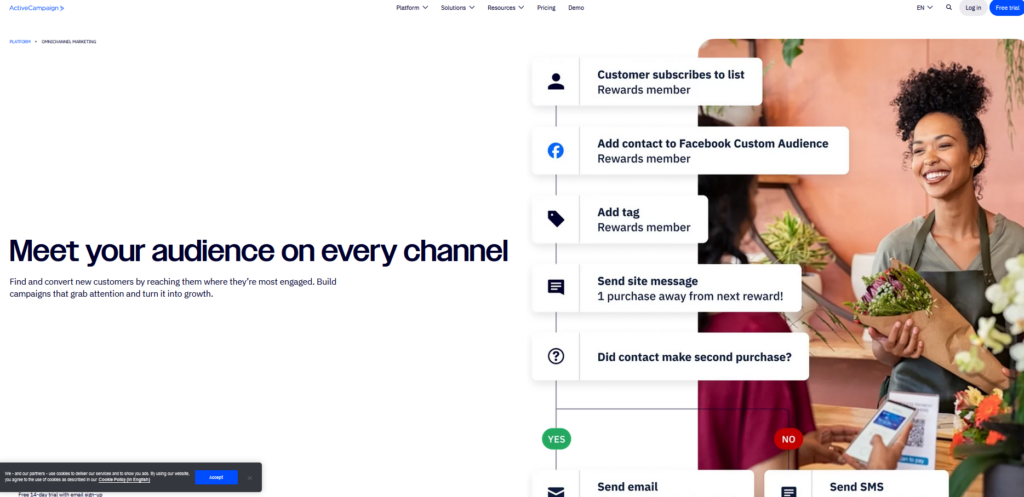
Omnichannel Marketing enables businesses to engage customers across multiple channels. It supports communication through email, SMS, social media, site messaging, and direct mail, ensuring consistent messaging and brand presence. By integrating these channels, businesses can reach their audience wherever they are.
The platform allows users to create unified campaigns that synchronize messages across different channels based on customer preferences and behaviors. For instance, a business can start an engagement with an email marketing campaign. Then, it can follow up with an SMS reminder or continue the conversation through social media. Finally, it could send a personalized direct mail piece as a finishing touch.
This coordinated approach ensures that customers receive timely and relevant communications, improving the effectiveness of marketing efforts.
3. Customer Relationship Management (CRM)
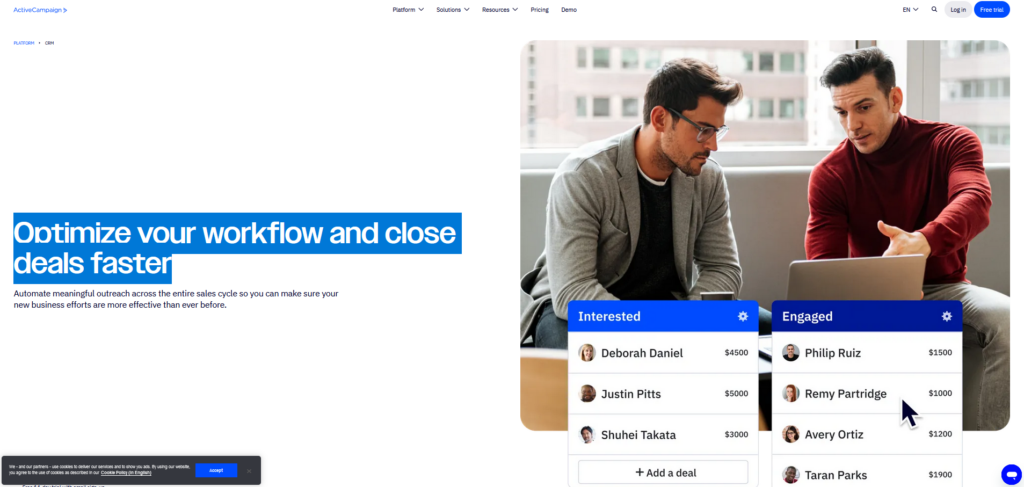
The platform’s CRM feature helps businesses manage and nurture their customer relationships effectively. It provides a comprehensive solution for tracking and engaging with leads and customers throughout their journey.
The CRM lets businesses capture detailed contact information and interaction history, enabling personalized communication. The presence of automated workflows streamlines tasks like follow-up emails, meeting scheduling, and deal updates, ensuring no opportunity is missed.
ActiveCampaign’s CRM offers a visual sales pipeline that provides an at-a-glance view of deal stages and progress. Customizable pipelines and task management tools allow teams to tailor the system to their specific needs, improving efficiency and collaboration and making it a one-stop solution.
4. Lead Scoring
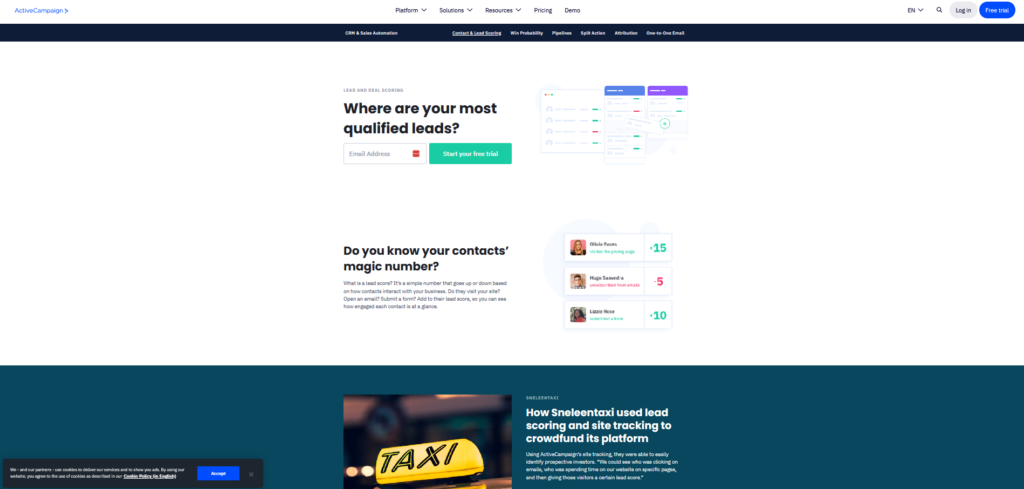
ActiveCampaign’s lead-scoring feature helps businesses prioritize and manage leads. It assigns scores based on their behavior, engagement, and interactions. This system lets sales and marketing teams focus on the most promising prospects.
You can set up criteria that reflect the value and readiness of a lead. Points are assigned for actions such as email opens, link clicks, website visits, or form submissions. These customizable rules allow businesses to tailor the scoring model to their specific needs and sales processes.
As leads accumulate points, they can be segmented into different categories, triggering automated workflows tailored to their score level. For example, high-scoring leads might receive direct outreach from the sales team. Lower-scoring leads can be nurtured with targeted content to build interest. This ensures that efforts focus on the most valuable leads, driving higher conversion rates and sales growth.
5. Reporting & Analytics
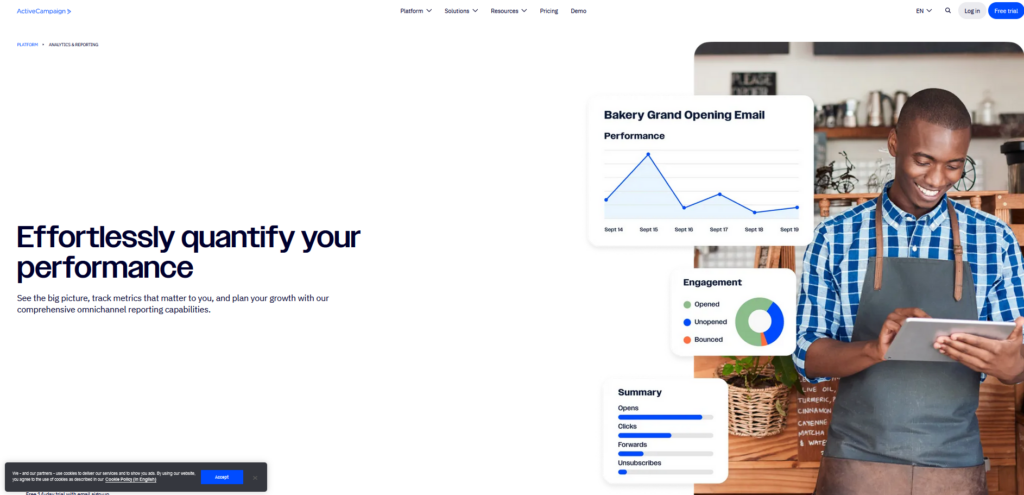
ActiveCampaign provides businesses with comprehensive insights into their marketing and sales activities. It enables users to track and analyze the performance of email campaigns, automation workflows, customer engagement, and marketing strategies.
The platform offers detailed reports on key metrics such as open rates, click-through rates, conversion rates, and customer behavior. These insights help businesses understand what is working and identify areas for improvement. Customizable dashboards allow users to visualize data in ways that are most relevant to their goals, making it easy to monitor progress and outcomes.
By leveraging these analytics, businesses can make data-driven decisions, optimize marketing efforts, and improve ROI.
6. Landing Pages
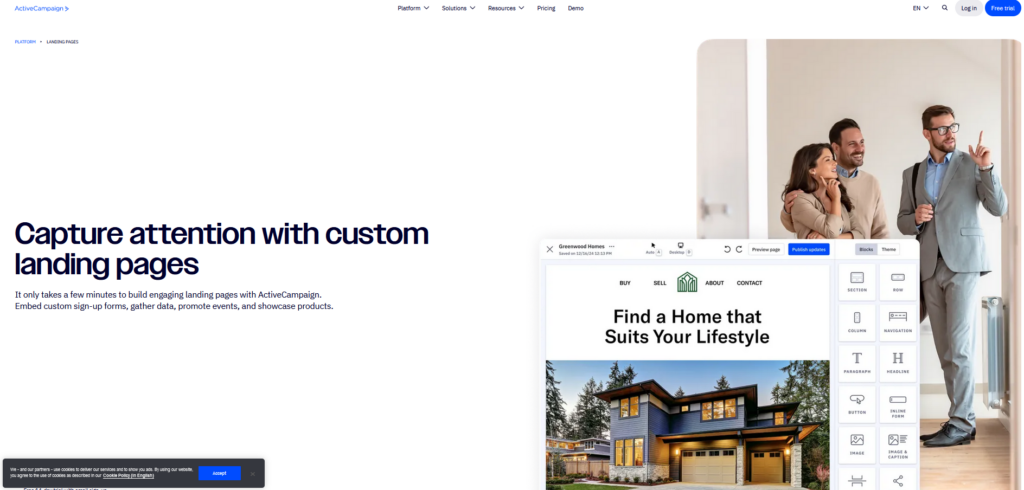
ActiveCampaign’s landing pages feature enables businesses to create high-converting, customizable web pages to capture leads and drive conversions. With a user-friendly drag-and-drop builder, users can design landing pages aligning with their branding goals. The best part is you don’t need extensive technical skills.
This feature includes a variety of pre-built templates optimized for different purposes, such as
- Lead generation,
- Event registrations,
- Product promotions.
Users can add and customize elements like text, images, forms, and call-to-action buttons to create engaging and effective landing pages.
7. Forms
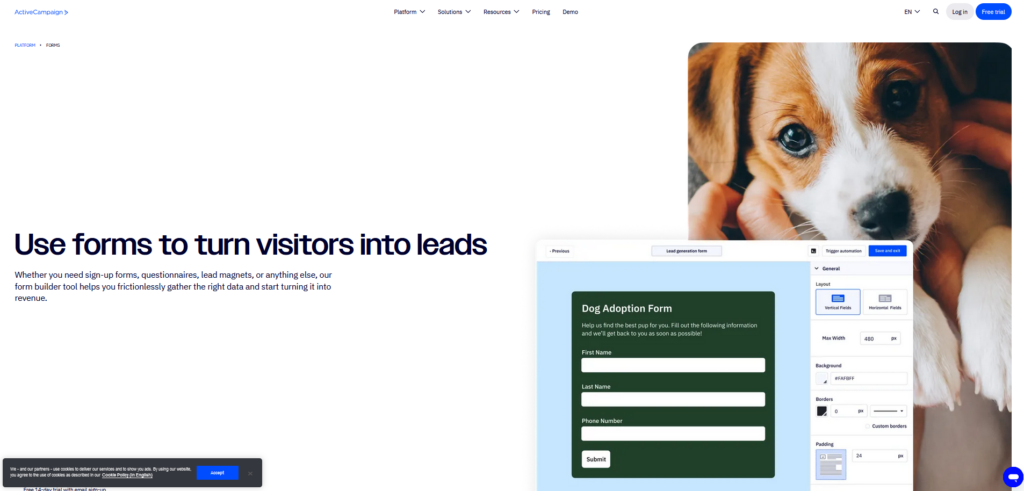
Create customized forms for capturing leads and gathering customer information seamlessly. The drag-and-drop form builder is user-friendly, enabling the creation of various types of forms, including inline, floating box, floating bar, and modal forms, without needing coding skills.
Users can tailor forms with fields for names, emails, phone numbers, and other relevant data and style them to match their branding. Advanced options like conditional logic enable personalized form experiences, showing or hiding fields based on user input. This helps in collecting precise and relevant information.
Forms can be embedded on websites, landing pages, or shared via direct links, integrating with ActiveCampaign’s email marketing and automation tools.
8. Integrations
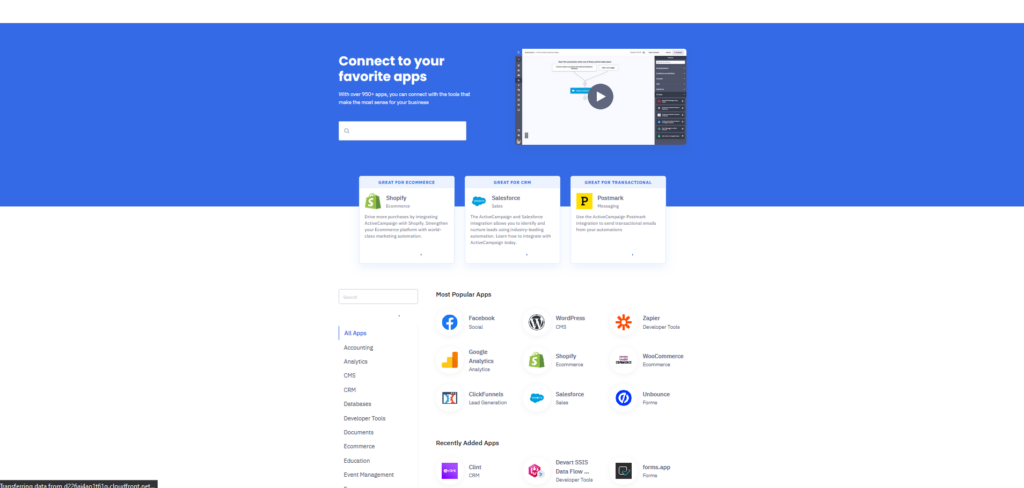
ActiveCampaign allows businesses to connect the platform with various third-party applications and services. With over 870 integrations, ActiveCampaign supports connections with popular tools in various categories, including CRM, e-commerce, social media, and customer support.
Integrations enable seamless data flow between ActiveCampaign and other platforms, ensuring that customer information, sales data, and marketing metrics are consistently updated and accessible across all tools. For example, integrating with direct mail automation platforms like Postalytics allows businesses to draw customer data and use it to personalize direct mail campaigns.
By leveraging these integrations, businesses can create a unified tech ecosystem, automate complex workflows, and gain deeper insights into customer behavior.
Pros of ActiveCampaign
Thousands of businesses have adopted and used ActiveCampaign. Here are five key benefits of this platform.
Ease of use
ActiveCampaign is designed for users of all skill levels. Its intuitive drag-and-drop interface allows users to create email campaigns, automation workflows, and landing pages without requiring technical expertise. The platform provides pre-built templates and straightforward customization options, enabling quick setup and deployment.
Their navigation is user-friendly. Clear menus and dashboards provide at-a-glance insights into performance metrics. The platform also offers in-app guidance, tutorials, and a knowledge base to help users understand the different features.
Integrating with other tools is simple, often requiring only a few clicks to connect and synchronize data.
Powerful automation
ActiveCampaign’s powerful automation capabilities enable businesses to create workflows that streamline marketing, sales, and customer relationship processes. Users can design automated sequences using a visual workflow builder. This simplifies the setup of complex automations without needing coding skills. These automations can trigger actions based on user behaviors, such as email opens, link clicks, or website visits.
The platform supports multi-step, conditional logic, allowing businesses to personalize customer journeys and deliver targeted messages at the right time. These automations integrate seamlessly with CRM and e-commerce systems, ensuring cohesive data flow and comprehensive customer insights.
High deliverability
ActiveCampaign ensures high deliverability rates for email campaigns. This maximizes the chances that emails reach recipients’ inboxes rather than their spam folders. This is achieved through several key practices. First, ActiveCampaign maintains strong relationships with major internet service providers (ISPs) to ensure trusted email delivery.
The platform also employs advanced email authentication methods, such as SPF, DKIM, and DMARC, which verify the legitimacy of emails. ActiveCampaign provides tools for list hygiene, helping users manage and clean their contact lists by removing inactive or invalid email addresses.
Users can monitor their email deliverability through detailed reports and adjust their strategies based on insights.
Template library
ActiveCampaign’s template library offers a wide variety of professionally designed templates to streamline the creation of email campaigns, landing pages, and forms. These templates help users quickly launch visually appealing and effective campaigns.
Each template is customizable using ActiveCampaign’s intuitive drag-and-drop editor. Users can modify text, images, colors, and layouts to match their brand identity and specific campaign needs. The templates are also responsive, ensuring that emails and pages look great on any device, from desktops to smartphones.
This saves time and effort, allowing businesses to focus on crafting compelling content and strategies rather than designing from scratch.
Powerful testing
ActiveCampaign enables businesses to optimize marketing efforts with A/B testing and detailed performance analysis. Using A/B testing, users can create multiple versions of emails, landing pages, or automation workflows to test different elements.
The platform distributes these variations to different audience segments to identify which version performs better. This is based on key metrics like open rates, click-through rates, and conversions. This data-driven approach allows businesses to refine their strategies for maximum effectiveness.
ActiveCampaign also provides comprehensive reports and analytics on test results, offering insights into customer preferences and behavior.
Cons of ActiveCampaign
While the platform has its benefits, below are five key cons which could be major factors for you to consider before subscribing to the tool.
Pricing structure
ActiveCampaign’s pricing structure can be a drawback for some businesses, especially smaller ones or startups with limited budgets. The platform offers multiple tiers based on features and the number of contacts, which can become expensive as the contact list grows. This scalability can lead to higher costs over time.
Additionally, certain features like CRM functionality and deep data integrations are only accessible in the more expensive tiers, potentially limiting the utility of lower-cost plans. Users may need to upgrade to access essential tools, increasing overall expenses. Thus, this structure may be a cause of concern for businesses looking for a cost-effective solution with comprehensive features right from the start.
Basic CRM
ActiveCampaign’s CRM, while integrated, can be considered basic compared to dedicated CRM systems. Though useful for contact management and automating sales processes, the CRM features lack depth and the advanced features found in specialized CRM platforms.
This might be a setback for businesses needing more advanced customer relationship management capabilities. For example, it may not offer as robust reporting, customization options, or scalability as other leading CRM systems. Users might find limitations in handling complex sales pipelines, detailed analytics, and extensive third-party integrations. Additionally, some essential CRM features are only available in higher-tier plans, which can add to the cost.
Limited design flexibility
ActiveCampaign’s limited design flexibility can be a drawback for businesses seeking highly customized or complex visual designs. While the platform offers templates and a drag-and-drop editor, users might find the customization options somewhat restrictive compared to dedicated design tools.
For instance, the ability to create intricate layouts, advanced styling, or unique interactive elements is limited. This can frustrate users who want to implement highly specific branding guidelines.
ActiveCampaign’s design tools are enough for basic needs. However, businesses looking for extensive design customization and creative flexibility should consider other options.
Limited customer support
ActiveCampaign’s limited customer support can be a disadvantage for users needing prompt assistance. The availability and quality of support vary by pricing tier, with more responsive and prioritized support reserved for higher-paying customers. Lower-tier plans often have access only to email support and community forums, leading to slower resolution times for urgent issues.
This limitation can hinder productivity for businesses that rely heavily on timely support to resolve technical challenges and ensure smooth operations.
No free plan
If you want to try ActiveCampaign for a while before subscribing, the lack of a free plan can be a huge drawback. Unlike many competitors that offer free tiers with essential features, ActiveCampaign only provides a 14-day free trial. After this trial, users must commit to a paid subscription to continue using the platform.
This absence of a free plan makes it challenging for businesses to evaluate the platform’s capabilities over an extended period or to use it at no cost while they grow.
Plans and Pricing of ActiveCampaign
ActiveCampaign offers four main pricing tiers. Each accommodates different business needs and scales.
- Lite: Starts at $29 per month. The Lite plan includes essential features such as email marketing, inline forms, marketing automation, and up to one user. It’s ideal for solopreneurs just beginning with marketing automation.
- Plus: Beginning at $49 per month. The Plus plan adds CRM with sales automation, contact and lead scoring, SMS marketing, custom user permissions, and integrations with tools like Facebook Custom Audiences and custom domains. This plan is suitable for small businesses needing more advanced marketing capabilities.
- Professional: Priced from $149 per month. The Professional plan offers all Plus features, plus predictive sending, win probability, split automation, site messaging, and up to 5 users. It’s aimed at businesses requiring more sophisticated marketing and sales tools.
- Enterprise: Starting at $259 per month. The Enterprise plan includes all Professional features, along with custom reporting, a dedicated account rep, in-depth onboarding, free design services, and unlimited users. This plan is best for larger organizations with complex needs.
Pricing varies based on contacts, with higher contact lists increasing the monthly cost.
Try Out ActiveCampaign-Postalytics Integration
ActiveCampaign is a marketing platform that is being adopted by a growing number of businesses.
If you work with direct marketing, you can integrate ActiveCampaign with Postalytics to manage direct campaigns seamlessly.
This integration allows businesses to send personalized postcards and letters triggered by customer actions within ActiveCampaign, such as sign-ups or purchases. Combining digital and physical marketing channels allows businesses to create a more comprehensive and engaging customer journey.
To learn more about this integration, get in touch with our integration expert today.
About the Author

Dennis Kelly
Dennis Kelly is CEO and co-founder of Postalytics. Dennis joined Boingnet, the predecessor to Postalytics, in 2013. Boingnet was focused on providing print and direct mail marketing service providers the ability to add digital marketing channels to their direct mail campaigns. Postalytics is Dennis’ 6th startup. He has been involved in starting and growing early-stage technology ventures for over 30 years and has held senior management roles at a diverse set of large technology firms including Computer Associates, Palm Inc. and Achieve Healthcare Information Systems.
